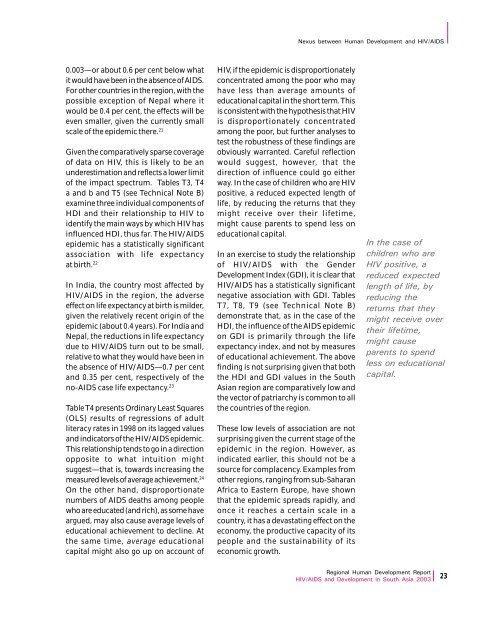Download Report - UNDP Asia-Pacific Regional Centre - United ...
Download Report - UNDP Asia-Pacific Regional Centre - United ...
Download Report - UNDP Asia-Pacific Regional Centre - United ...
You also want an ePaper? Increase the reach of your titles
YUMPU automatically turns print PDFs into web optimized ePapers that Google loves.
Nexus between Human Development and HIV/AIDS0.003—or about 0.6 per cent below whatit would have been in the absence of AIDS.For other countries in the region, with thepossible exception of Nepal where itwould be 0.4 per cent, the effects will beeven smaller, given the currently smallscale of the epidemic there. 21Given the comparatively sparse coverageof data on HIV, this is likely to be anunderestimation and reflects a lower limitof the impact spectrum. Tables T3, T4a and b and T5 (see Technical Note B)examine three individual components ofHDI and their relationship to HIV toidentify the main ways by which HIV hasinfluenced HDI, thus far. The HIV/AIDSepidemic has a statistically significantassociation with life expectancyat birth. 22In India, the country most affected byHIV/AIDS in the region, the adverseeffect on life expectancy at birth is milder,given the relatively recent origin of theepidemic (about 0.4 years). For India andNepal, the reductions in life expectancydue to HIV/AIDS turn out to be small,relative to what they would have been inthe absence of HIV/AIDS—0.7 per centand 0.35 per cent, respectively of theno-AIDS case life expectancy. 23Table T4 presents Ordinary Least Squares(OLS) results of regressions of adultliteracy rates in 1998 on its lagged valuesand indicators of the HIV/AIDS epidemic.This relationship tends to go in a directionopposite to what intuition mightsuggest—that is, towards increasing themeasured levels of average achievement. 24On the other hand, disproportionatenumbers of AIDS deaths among peoplewho are educated (and rich), as some haveargued, may also cause average levels ofeducational achievement to decline. Atthe same time, average educationalcapital might also go up on account ofHIV, if the epidemic is disproportionatelyconcentrated among the poor who mayhave less than average amounts ofeducational capital in the short term. Thisis consistent with the hypothesis that HIVis disproportionately concentratedamong the poor, but further analyses totest the robustness of these findings areobviously warranted. Careful reflectionwould suggest, however, that thedirection of influence could go eitherway. In the case of children who are HIVpositive, a reduced expected length oflife, by reducing the returns that theymight receive over their lifetime,might cause parents to spend less oneducational capital.In an exercise to study the relationshipof HIV/AIDS with the GenderDevelopment Index (GDI), it is clear thatHIV/AIDS has a statistically significantnegative association with GDI. TablesT7, T8, T9 (see Technical Note B)demonstrate that, as in the case of theHDI, the influence of the AIDS epidemicon GDI is primarily through the lifeexpectancy index, and not by measuresof educational achievement. The abovefinding is not surprising given that boththe HDI and GDI values in the South<strong>Asia</strong>n region are comparatively low andthe vector of patriarchy is common to allthe countries of the region.These low levels of association are notsurprising given the current stage of theepidemic in the region. However, asindicated earlier, this should not be asource for complacency. Examples fromother regions, ranging from sub-SaharanAfrica to Eastern Europe, have shownthat the epidemic spreads rapidly, andonce it reaches a certain scale in acountry, it has a devastating effect on theeconomy, the productive capacity of itspeople and the sustainability of itseconomic growth.In the case ofchildren who areHIV positive, areduced expectedlength of life, byreducing thereturns that theymight receive overtheir lifetime,might causeparents to spendless on educationalcapital.<strong>Regional</strong> Human Development <strong>Report</strong>HIV/AIDS and Development in South <strong>Asia</strong> 2003 23
















